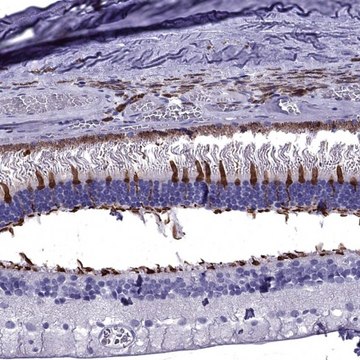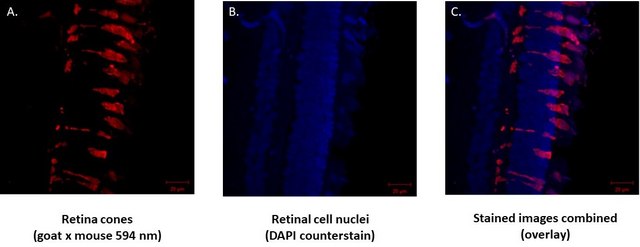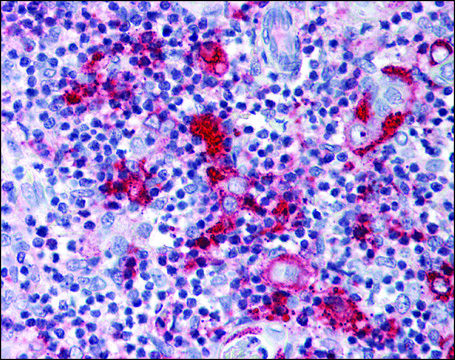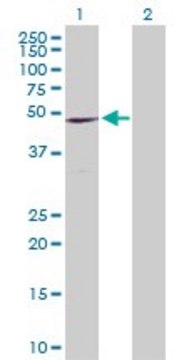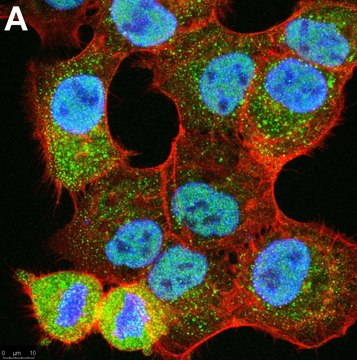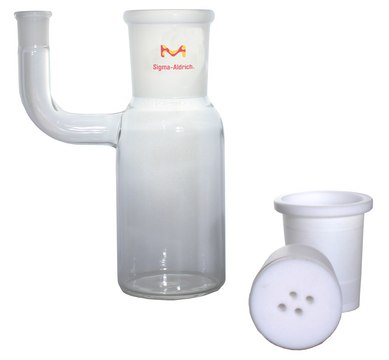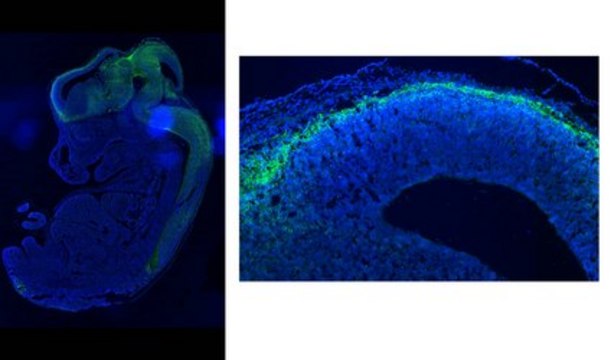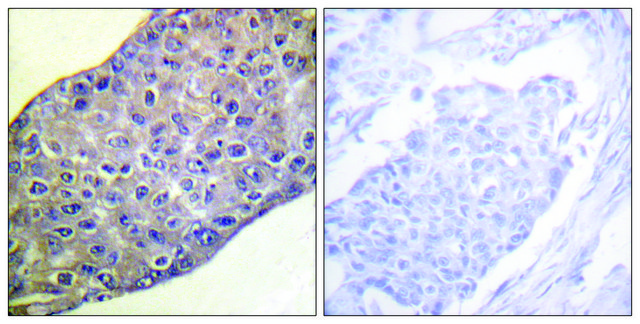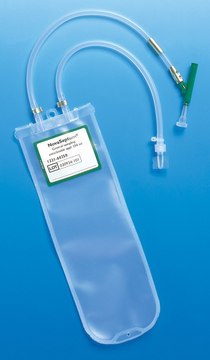推荐产品
生物来源
rat
质量水平
偶联物
unconjugated
抗体形式
purified antibody
抗体产品类型
primary antibodies
克隆
7E7, monoclonal
分子量
calculated mol wt 41.91 kDa
纯化方式
using protein G
种属反应性
mouse, human
包装
antibody small pack of 100 μg
技术
flow cytometry: suitable
immunofluorescence: suitable
immunohistochemistry (formalin-fixed, paraffin-embedded sections): suitable
同位素/亚型
IgG2b
表位序列
N-terminal
Protein ID登记号
UniProt登记号
运输
ambient
靶向翻译后修饰
unmodified
基因信息
human ... TACSTD2(4070)
一般描述
C-C chemokine receptor type 9 (UniProt: Q9WUT7; also known as C-C CKR-9, CC-CKR-9, CCR-9, Chemokine C-C receptor 10, CDw199) is encoded by the Crr9 (also known as Cmkbr10) gene (Gene ID: 12769) in murine species. CCR9 is a multi-pass membrane protein of the G-protein coupled receptor 1 family. It has four extracellular domains, seven transmembrane domains, and four cytoplasmic domains and serves as a receptor for chemokine CCL25/TECK. It is highly expressed in the thymus tissue. It is also expressed on virtually all small intestinal T cells and IgA-producing plasma cells (PCs) from the spleen. It is reported to be crucial for the positioning of PCs to the small intestine. Higher expression of CCR9 is observed in newly generated PCs and it is down-regulated once these cells reach their final destination in the intestine. In wild-type mice, a majority of the PCs are shown to locate to the lower half of the villus where CCL25 is also expressed at high levels. CCR9 deficient mice exhibit reduced number of PCs in the intestine and are unable to mount a T cell dependent antigen specific IgA response. CCR9-/- hematopoietic stem cells are deficient in their ability to generate all major thymocyte subsets. (Ref.: Svensson, M., et al. (2008). J. Leukoc. Biol. 83(1); 156-164; Pabst, O., et al. (2004). J. Exp. Med. 199(3); 411-416).
特异性
Clone 7E7 is a rat monoclonal antibody that detects C-C chemokine receptor type 9 (CCR9). It targets an epitope within 20 amino acids from the fist extracellular domain in the N-terminal region.
免疫原
KLH-conjugated linear peptide corresponding to 20 amino acids from the first extracellular domain in the N-terminal region of mouse C-C-chemokine receptor type 9 (CCR9).
应用
Quality Control Testing
Evaluated by Flow Cytometry in BALB/c mouse thymocytes.
Flow Cytometry Analysis: 1 μg of this antibody detected CCR9 in one million BALB/c mouse thymocytes.
Tested Applications
Immunohistochemistry Applications: A representative lot detected CCR9 in Immunohistochemistry applications (Guo, Z., et al. (2008). Int Immunol. 20(3):307-15; Pabst, O., et al. (2004). J Exp Med. 199(3):411-6; McGuire, H.M., et al. (2011). Immunity. 34(4):602-15).
Flow Cytometry Analysis: A representative lot detected CCR9 in Flow Cytometry applications (Guo, Z., et al. (2008). Int Immunol. 20(3):307-15; Pabst, O., et al. (2004). J Exp Med. 199(3):411-6; McGuire, H.M., et al. (2011). Immunity. 34(4):602-15; Svensson, M., et al. (2008). J Leukoc Biol. 83(1):156-64; Chennupati, V., et al. (2010). J Immunol. 185(9):5160-8).
Immunofluorescence Analysis: A representative lot detected CCR9 in Immunofluorescence applications (Guo, Z., et al. (2008). Int Immunol. 20(3):307-15; Pabst, O., et al. (2004). J Exp Med. 199(3):411-6; McGuire, H.M., et al. (2011). Immunity. 34(4):602-15).
Note: Actual optimal working dilutions must be determined by end user as specimens, and experimental conditions may vary with the end user
Evaluated by Flow Cytometry in BALB/c mouse thymocytes.
Flow Cytometry Analysis: 1 μg of this antibody detected CCR9 in one million BALB/c mouse thymocytes.
Tested Applications
Immunohistochemistry Applications: A representative lot detected CCR9 in Immunohistochemistry applications (Guo, Z., et al. (2008). Int Immunol. 20(3):307-15; Pabst, O., et al. (2004). J Exp Med. 199(3):411-6; McGuire, H.M., et al. (2011). Immunity. 34(4):602-15).
Flow Cytometry Analysis: A representative lot detected CCR9 in Flow Cytometry applications (Guo, Z., et al. (2008). Int Immunol. 20(3):307-15; Pabst, O., et al. (2004). J Exp Med. 199(3):411-6; McGuire, H.M., et al. (2011). Immunity. 34(4):602-15; Svensson, M., et al. (2008). J Leukoc Biol. 83(1):156-64; Chennupati, V., et al. (2010). J Immunol. 185(9):5160-8).
Immunofluorescence Analysis: A representative lot detected CCR9 in Immunofluorescence applications (Guo, Z., et al. (2008). Int Immunol. 20(3):307-15; Pabst, O., et al. (2004). J Exp Med. 199(3):411-6; McGuire, H.M., et al. (2011). Immunity. 34(4):602-15).
Note: Actual optimal working dilutions must be determined by end user as specimens, and experimental conditions may vary with the end user
Anti-CCR9, clone 7E7, Cat. No. MABF2791, is a rat monoclonal antibody that detects CCR9 and is tested for use in Flow Cytometry, Immunofluorescence, and Immunohistochemistry.
外形
Purified rat monoclonal antibody IgG2b in buffer containing 0.1 M Tris-Glycine (pH 7.4), 150 mM NaCl with 0.05% sodium azide.
储存及稳定性
Recommended storage: +2°C to +8°C.
其他说明
Concentration: Please refer to the Certificate of Analysis for the lot-specific concentration.
免责声明
Unless otherwise stated in our catalog or other company documentation accompanying the product(s), our products are intended for research use only and are not to be used for any other purpose, which includes but is not limited to, unauthorized commercial uses, in vitro diagnostic uses, ex vivo or in vivo therapeutic uses or any type of consumption or application to humans or animals.
未找到合适的产品?
试试我们的产品选型工具.
储存分类代码
12 - Non Combustible Liquids
WGK
WGK 1
法规信息
新产品
我们的科学家团队拥有各种研究领域经验,包括生命科学、材料科学、化学合成、色谱、分析及许多其他领域.
联系技术服务部门